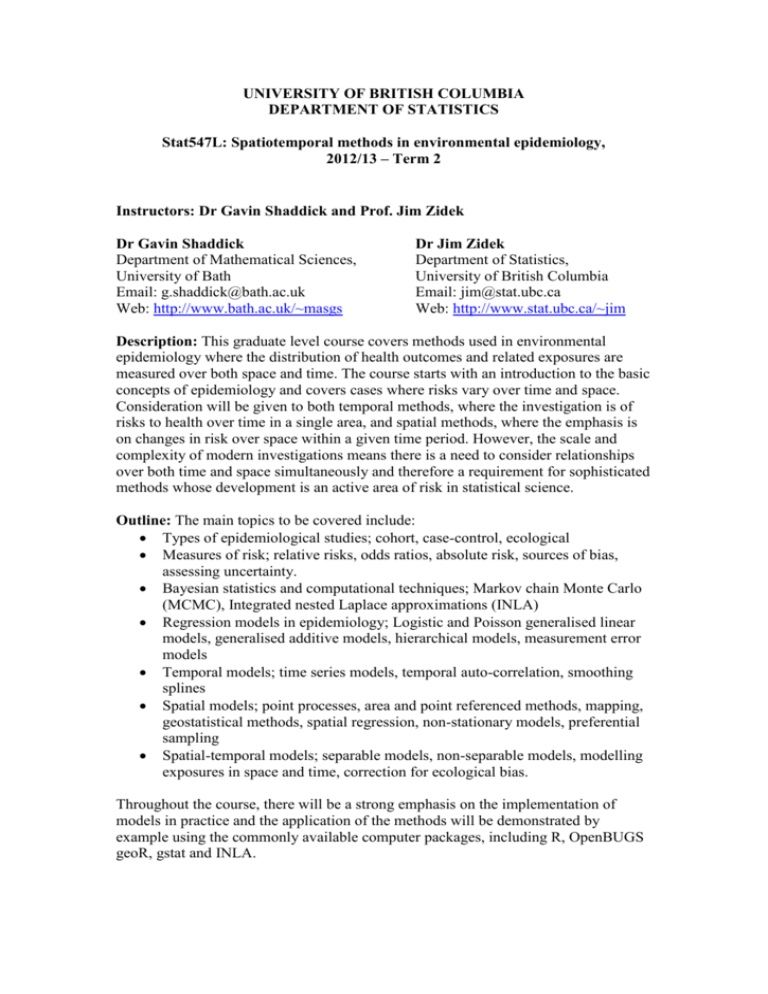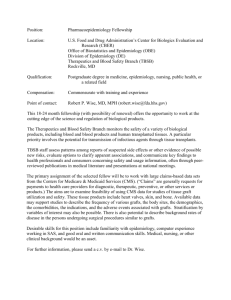STAT547Loutline20120706JZGS
advertisement

UNIVERSITY OF BRITISH COLUMBIA DEPARTMENT OF STATISTICS Stat547L: Spatiotemporal methods in environmental epidemiology, 2012/13 – Term 2 Instructors: Dr Gavin Shaddick and Prof. Jim Zidek Dr Gavin Shaddick Department of Mathematical Sciences, University of Bath Email: g.shaddick@bath.ac.uk Web: http://www.bath.ac.uk/~masgs Dr Jim Zidek Department of Statistics, University of British Columbia Email: jim@stat.ubc.ca Web: http://www.stat.ubc.ca/~jim Description: This graduate level course covers methods used in environmental epidemiology where the distribution of health outcomes and related exposures are measured over both space and time. The course starts with an introduction to the basic concepts of epidemiology and covers cases where risks vary over time and space. Consideration will be given to both temporal methods, where the investigation is of risks to health over time in a single area, and spatial methods, where the emphasis is on changes in risk over space within a given time period. However, the scale and complexity of modern investigations means there is a need to consider relationships over both time and space simultaneously and therefore a requirement for sophisticated methods whose development is an active area of risk in statistical science. Outline: The main topics to be covered include: Types of epidemiological studies; cohort, case-control, ecological Measures of risk; relative risks, odds ratios, absolute risk, sources of bias, assessing uncertainty. Bayesian statistics and computational techniques; Markov chain Monte Carlo (MCMC), Integrated nested Laplace approximations (INLA) Regression models in epidemiology; Logistic and Poisson generalised linear models, generalised additive models, hierarchical models, measurement error models Temporal models; time series models, temporal auto-correlation, smoothing splines Spatial models; point processes, area and point referenced methods, mapping, geostatistical methods, spatial regression, non-stationary models, preferential sampling Spatial-temporal models; separable models, non-separable models, modelling exposures in space and time, correction for ecological bias. Throughout the course, there will be a strong emphasis on the implementation of models in practice and the application of the methods will be demonstrated by example using the commonly available computer packages, including R, OpenBUGS geoR, gstat and INLA. Prerequisites: The course assumes a solid background in statistics, although the required material will be briefly reviewed and graduate students in Statistics would qualify. There will be no assumption of a background in epidemiology. If you are unsure, contact an instructor by email with your (unofficial) graduate and undergraduate transcripts attached. Lab: Subject to the availability of space and the necessary support, we will have a laboratory program of hands-on study. This will include an introduction to the statistical packages with lab assignments based on them. Evaluation: Final grades will be based on assignments, laboratory exercises, and projects. Textbook:Various options are under consideration, but none has been selected as the outline was being prepared. References: Epidemiology: Lawson A. (2006) Statistical Methods in Spatial Epidemiology (2nd edition). Wiley Thomas, D. (2009) Statistical Methods in Environmental Epidemiology. Oxford University Press Rothman K.(2012) Epidemiology: An Introduction (2nd edition). Oxford University Press. Rothman K, Greenland S, Lash T. (2008) Modern epidemiology (3rd edition). Lippencott, Williams & Wilkins Ward H, Toledano M, Shaddick G, Davies B, Elliott P. (2012) Oxford Handbook of Epidemiology for Clinicians. Oxford University Press. Spatial and temporal statistics: Banerjee S, Gelfand A, Carlin P. (2005) Hierarchical Modeling and Analysis for Spatial Data. Chapman & Hall/CRC. Cressie N, Wilke C. (2011) Statistics for spatio-temporal data. Wiley. Diggle P. (2002) Statistical analysis of spatial point pattern (2nd edition) Hodder Education Diggle P, Ribeiro P. (2007) Model-based geostatistics. Springer. Le N, Zidek J. (2006) Statistical Analysis of Environmental Space-Time Processes. Springer Schabenberger O, Gotway C. (2004) Statistical Methods for Spatial Data Analysis . Chapman & Hall/CRC.



